FREE shipping on orders over $49!* Details
Baby Cribs
200 Results
Sort by:
Price
200 Results
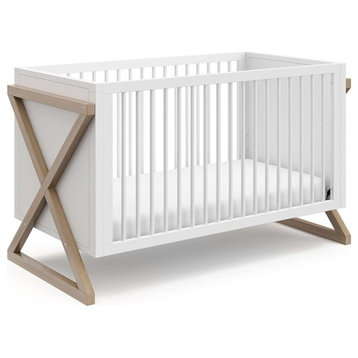
Storkcraft Equinox 3 in 1 Convertible Crib in White and Driftwoodby Stork Craft
$312
Free Shipping
Stylish design for your trendy baby, the Equinox 3 in 1 convertible crib is a truly unique crib with a modern structure, distinguished by its strong frame lines and a two-tone design. It’s the heart of the contemporary nursery. As your baby grows, so can this crib, with its three-position adjustable mattress support base and quick transition into a toddler bed, and daybed. Our team designs products with real family safety in mind like they’re designing for their own children. Like all our cribs, Storkcraft Equinox 3 in 1 convertible crib is certified by the Juvenile Products Manufacturers Association (JPMA) and is meticulously tested to meet or exceed all applicable American Society for Testing and Materials (ASTM) safety standards to ensure the safest sleeping environment for your child. It’s important we focus on all the details, so you can focus on the family moments.
Features :
- Finish: White and Vintage Driftwood
- Recommended maximum child weight (for toddler bed and daybed stages) is 50 lbs
- Material: High-Quality Pine Wood and Composites
- Non-toxic finish
- Storkcraft toddler guardrail sold separately
- Fits standard size crib mattress (sold separately)
- JPMA certified and meets or exceeds all ASTM standards
- 1-year limited manufacturer’s warranty
Specifications :
- Product Dimensions : 35.02" H x 58.15" W x 29.53" D
- Product Weight : 70 lbs
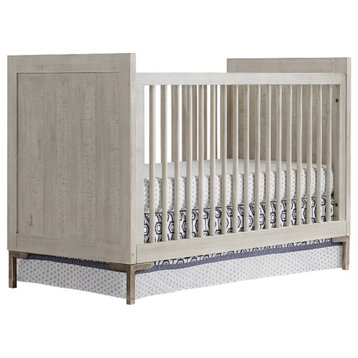
Westwood Design Beck Modern Wood Cottage Crib in Willow Gray Finishby Westwood Design
$415
Free Shipping
The Beck collection offers a sleek modern look without being too grown up for your little one. Unique Willow finish is complimented perfectly by the dark antique bronze metal hardware. Let this elegant nursery collection easily elevate your child’s room, with Convertible and Cottage Crib options pick the one that best fits your style or needs!
Features :
- Materials: Solid hardwood
- Finish: Willow
- Steel spring mattress support with three height adjustments
- Sturdy design for easy conversion
Specifications :
- Product Dimensions : 38.97"H x 54.84"W x 30"D
- Product Weight : 71.25 lbs
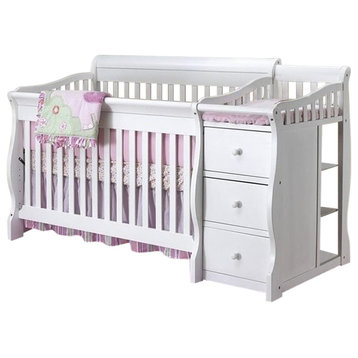
Pemberly Row 4 in 1 Convertible Wood Crib and Changer Combo in Whiteby Pemberly Row
$538
Free Shipping
SponsoredEmbrace functionality and style with the Pemberly Row 4 in 1 Convertible Crib and Changer Combo in White. This versatile crib and changer combo offers a space-saving solution for your nursery. The white finish exudes purity and charm, while the convertible design allows you to transition from crib to toddler bed to daybed. The attached changer provides convenience and efficiency, making it easy to care for your little one. Create a nurturing and stylish environment for your baby with this crib and changer combo that combines practicality and aesthetics.
Features :
- Finish: White
- Nicki Solid Pine Changing Table in French White SKU: 67-FW
- 1 year warranty
- Material: solid wood and wood veneers, including Poplar and New Zealand Pine
- Adult Full-Size Bed Conversion Rails SKU: 215-X
- JPMA certified
- Crib Size: Standard Convertible
- Serta Nightstar Supreme Crib Mattress in Green SKU: A43320-1105
- Meets ASTM crib safety standards and US safety requirements
- Converts to toddler bed, daybed, and full-size bed
- Nicki Solid Pine Changing Table in French White SKU: 67-FW
- 1 year warranty
- Mattress NOT included
- JPMA certified
- Adult and Toddler Rails NOT included
- Meets ASTM crib safety standards and US safety requirements
- Takes a 52"L x 27.5"W mattress up to 6" thick
- Adjustable Mattress Levels: Yes - 4 Levels
- Includes: changer with 3 drawer chest and change pad
- Lead free
- Fixed side rails
- Finish: White
- Material: solid wood and wood veneers, including Poplar and New Zealand Pine
- Crib Size: Standard Convertible
- Converts to toddler bed, daybed, and full-size bed
- Adult and Toddler Rails NOT included
- Takes a 52"L x 27.5"W mattress up to 6" thick
- Adjustable Mattress Levels: Yes - 4 Levels
- Includes: changer with 3 drawer chest and change pad
- Lead free
- Fixed side rails
Best Seller
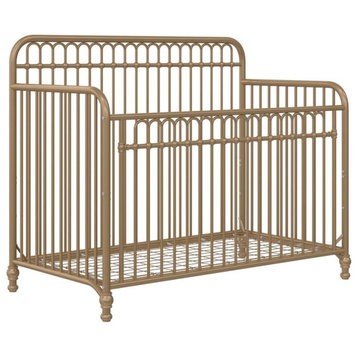
Little Seeds Modern Ivy 3-in-1 Convertible Metal Crib Nursery Furniture in Goldby DHP(150)
$458
Free Shipping
Let’s face it – searching through multiple convertible cribs to complete your little one’s vintage nursery décor can be daunting, but let Little Seeds take you away from decision anxiety right now with the Monarch Hill Ivy 3-in-1 Metal Convertible Crib. With its beautifully arched metal frame and decorative ball castings, this beautiful metal crib will be to your nursery design what the little black dress is to women’s fashion - timelessly classic. The Ivy Convertible Crib starts off as a traditional metal baby crib, offering three adjustable mattress heights as your new baby grows. Once your little one is ready for their first big kid bed, simply add the included toddler rail to easily convert the crib to a toddler bed. The convertible crib then has one final evolution as a day bed with the mattress height in the lowest position and the toddler rail removed. The Monarch Hill Ivy 3-in-1 Metal Convertible Crib fits a standard size crib mattress (sold separately), and for further peace of mind, it also meets ASTM testing standards to ensure your child’s safety. Little Seeds not only creates this and many more on trend baby and kids’ furniture pieces, we also partner with the National Wildlife Federation’s Garden for Wildlife program to help save the Monarch butterfly.
Features :
- Modern style metal crib that features round accents on the railing. Great option for nurseries of any design.
- 3-in-1 convertible crib that easily converts between a crib, toddler bed and daybed (toddler guardrail included). Fits a standard size crib mattress (sold separately).
- Sturdy metal construction with 3 adjustable mattress positions to adapt the height as your child grows.
- Ships in one box. Quick and easy assembly required. Available in multiple colors. Meets ASTM standards.
- Product dimensions: 55.5”L x 30.5”W x 44.5”H. Weight limit: 50 lbs. Net weight: 62.5 lbs. Shipping dimensions: 58”L x 42”W x 7”H. Gross weight: 72 lbs.
Specifications :
- Product Dimensions : 44.5 H x 55.5 W x 30.5 D
- Product Weight : 62.5
- Weight Capacity : 50
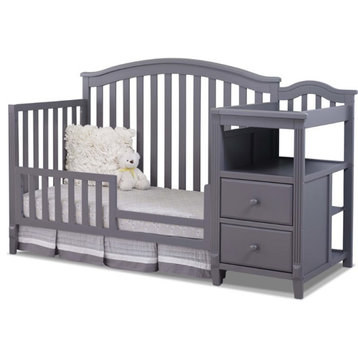
Sorelle Berkley Crib and Changer in Grayby sorelle(220)
$394
Free Shipping
All-in-one crib with changer and storage drawers. The changer only detaches from the crib once you are ready to convert to a full size bed. Features sturdy construction in a durable painted finish. This crib converts into a toddler bed, day bed and a full size bed!
Features :
- Finish: Gray
- Brings style and versatility to your nursery with and open shelf and 2 drawers for ample storage and organization
- Open slat design with beautiful rounded detailing
- Changing table is on the right side only
- Converts from crib to toddler bed with the Berkley Toddler Guard Rail (sold separately); also converts to a daybed
- Converts to a full size bed with the Berkley Full Size Bed Rails (sold separately)
- Meets ASTM standards
- 1 year limited warranty.
- The toddler rail (item#148) and adult rails (item#224) sold separtely.
Specifications :
- Product Dimensions : 46.00" H x 73.00" W x 30.00" D
- Product Weight : 81 lbs
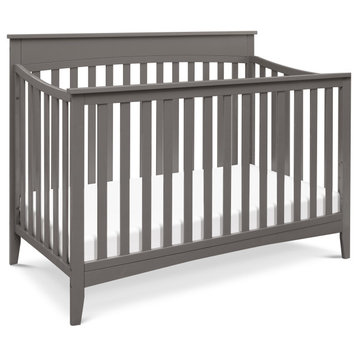
Grove 4-In-1 Convertible Crib in Chestnut, Slateby DaVinci(136)
$263
Free Shipping
SponsoredThe simple elegance and sturdy construction of the Grove 4-in-1 Convertible Crib by DaVinci make it a stylish nursery staple to be enjoyed for years to come. Constructed with sustainable New Zealand pine wood, and finished with non-toxic materials, the Grove is stylish as it is safe. Enjoy the classic understated beauty of the Grove crib as your child grows from infancy into the grade school years; the Grove crib features four adjustable mattress positions and is designed to convert from crib to toddler bed, daybed and full-size bed. Complete your nursery; pairs with dressers from our DaVinci Autumn collection and Jayden collection.
- GREENGUARD GOLD CERTIFIED: This product has been tested for over 10,000 chemical emissions and VOCs, undergoing rigorous scientific testing to meet some of the world's most stringent chemical emissions requirements. It contributes to cleaner indoor air, creating a healthier environment for your baby to sleep, play, and grow.
- 4-in-1 CONVERTIBILITY: Designed to save you the hassle (and extra money!) of buying multiple beds as your little one grows. Easily converts to a toddler bed, daybed, and full-size bed (toddler kit #M12599 and full-size kit #M5789 sold separately).
- GROWS WITH BABY: 4 adjustable mattress positions that you can lower as your baby begins to sit and stand. We've built this crib to withstand even the most active babies and toddlers and last through your child's teen years
- QUALITY MATERIAL: Made of solid sustainable New Zealand pinewood and TSCA compliant engineered wood - only the best for your sweet baby
- FOR YOUR BABY'S SAFETY: Say goodbye to toxic chemicals! Finished in a non-toxic multi-step painting process and lead and phthalate safe. Rest assured knowing it meets or exceeds ASTM International and U.S. CPSC safety standards
- MATTRESS COMPATIBILITY: While this crib is a standard size regular crib, for a best fit we recommend DaVinci’s line of non-toxic, GREENGUARD gold, waterproof mattresses
- COMPLETE THE LOOK: Shop Kalani 6-Drawer Dresser and Kalani 3-Drawer Dresser for a coordinated nursery
Best Seller
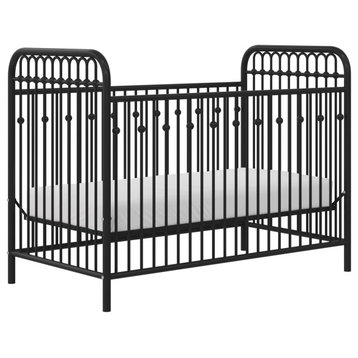
Little Seeds Monarch Hill Ivy Black Metal Baby Cribby Little Seeds(357)
$284
Free Shipping
Let's face it - looking at dozens of baby cribs to find the perfect one to complement your little one's vintage nursery decor can be daunting, but let Little Seeds ease some of your decision anxiety with the Monarch Hill Ivy White Metal Crib. With its beautifully arched metal frame and decorative ball castings, the Little Seeds Monarch Hill Ivy White Metal Crib will be to nursery design what the little black dress is to women's fashion - timelessly classic. Not only will your chic choice blend seamlessly with a modern or vintage style, the metallic white crib mattress support also adjusts to 3 different heights, giving your baby more dream time in their crib until it's time to graduate to a Little Seeds Toddler Bed (Sold Separately). Little Seeds not only creates this and many more on trend baby furniture pieces, but we also partner with various environmental protection programs to protect pollinator and other wildlife habitats for future generations.
- Made of sturdy powder-coated metal with a non-toxic finish
- The crib mattress support adjusts to 3 different heights as your child grows and fits a standard size crib mattress (not included)
- Stop using the crib when your child begins to climb out or once they are 35" tall and upgrade to a Little Seeds Toddler Bed (sold separately)
- 1 year limited warranty
- The baby crib can support up to 30 lbs.
- Assembled dimensions: 40.63"H x 54.5"W x 29.45"D. Net Weight: 48.5 lbs
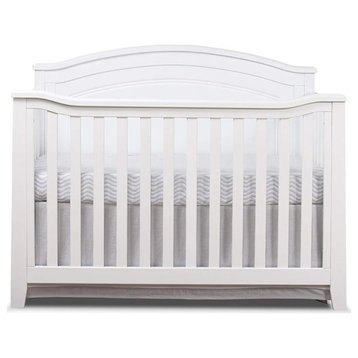
Sorelle Berkley Round Top Panel Crib in Whiteby sorelle(358)
$281
Free Shipping
The 4-in-1 crib converts to a toddler bed, daybed and full-size bed and offers three mattress positions to suit your child’s changing needs. Made from sturdy poplar wood, the crib is built to last.
Features :
- Finish: White
- Open slat design with beautiful rounded detailing; Solid round top panel headboard
- 3 adjustable mattress height positions
- Converts from crib to toddler bed with the Berkley Toddler Guard Rail (sold separately); also converts to a daybed
- Converts to a full size bed with the Berkley Full Size Bed Rails (sold separately)
- 1-year limited manufacturer's warranty
- Meets ASTM standards
- 1 year limited warranty.
- The toddler rail (Item# 148) and adult rails (Item# 221) sold separately.
Specifications :
- Product Dimensions : 44.00" H x 55.00" W x 30.00" D
- Product Weight : 60 lbs
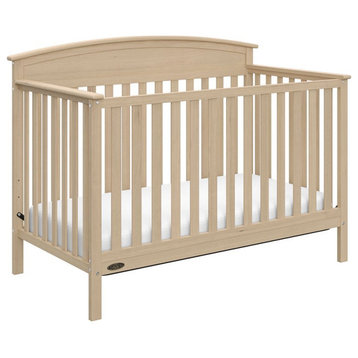
Graco Benton 5 in 1 Convertible Crib in Driftwoodby Stork Craft USA(1175)
$321
Free Shipping
Designed for many years of use, the Graco Benton 5 in 1 convertible crib can easily convert from a crib to a toddler bed, daybed and full-size bed, either with headboard-only or headboard and footboard (universal bed rails sold separately). The crib can easily and safely hold any standard-sized crib mattress, with adjustable mattress heights to suit the needs of your child. The Graco Benton 5 in 1 convertible crib is JPMA certified and is compliant with all ASTM safety standards to ensure the safest sleeping environment for your child.
Features :
- Finish: Driftwood
- Recommended maximum child weight (for toddler bed and daybed stages) is 50 lbs
- Material: Wood
- Three-position adjustable mattress base to accommodate your baby's growth
- JPMA certified and meets or exceeds all ASTM standards
- 1-year limited manufacturer’s warranty
Specifications :
- Product Dimensions : 43.2" H x 56.7" W x 29.8" D
- Product Weight : 41 lbs
Best Seller
Jenny Lind 3-in-1 Convertible Crib, Navyby DaVinci(489)
$290
Free Shipping
DaVinci's beloved Jenny Lind 3-in-1 Convertible Crib brings classic, vintage-inspired charm to the nursery. Signature heirloom style and solid wood spindle posts are paired with easy assembly and convertibility for use beyond the nursery years. Crib converts to toddler bed and daybed, with wheels included for mobility. Match with the Jenny Lind Changing Table to complete the collection.
The timeless Jenny Lind Collection by DaVinci brings vintage-inspired charm to the nursery. The award-winning Jenny Lind 3-in-1 Convertible Crib pairs classic style and solid wood spindle posts with easy assembly and convertibility. A matching Jenny Lind Changing Table to store all of baby's sweet treasures completes the versatile collection.
Our mission is to provide parents with peace of mind at excellent value. Each product is thoughtfully designed and thoroughly tested, and we actively partner with the leading authorities on safety to provide you with only the safest products for your family. As a result, our award-winning products are consistently recognized for their excellence by the leading consumer and parenting resources.
We are proud to have served over one million families with beautiful products that are rigorously tested, trusted by the leading industry experts, and loved by parents.
The timeless Jenny Lind Collection by DaVinci brings vintage-inspired charm to the nursery. The award-winning Jenny Lind 3-in-1 Convertible Crib pairs classic style and solid wood spindle posts with easy assembly and convertibility. A matching Jenny Lind Changing Table to store all of baby's sweet treasures completes the versatile collection.
Features:
- GREENGUARD Gold Certified
- Meets ASTM international and U.S. CPSC safety standards
- Converts to toddler bed and daybed
- Toddler bed conversion kit included
- Four adjustable mattress positions
- Wheels included
- Finished in non-toxic multi-step painting process, lead and phthalate safe
- Made of 100% sustainable New Zealand pine wood
- Max weights: toddler bed = 50 lbs
- Slat strength: 135 lbs
- 1-year warranty
Our mission is to provide parents with peace of mind at excellent value. Each product is thoughtfully designed and thoroughly tested, and we actively partner with the leading authorities on safety to provide you with only the safest products for your family. As a result, our award-winning products are consistently recognized for their excellence by the leading consumer and parenting resources.
We are proud to have served over one million families with beautiful products that are rigorously tested, trusted by the leading industry experts, and loved by parents.
Best Seller
Scoot 3-in-1 Convertible Crib & Toddler Bed Conversion Kit White/Washed Naturalby Babyletto(514)
$416
Free Shipping
The Scoot 3-in-1 Convertible Crib is the perfect centerpiece to your mid-century modern nursery. Its retro-inspired features add a charming vibe for babe's new space. Modern and functional, an included toddler bed conversion kit allows you to seamlessly convert from crib to toddler bed to daybed as your babe grows. Breathe easy knowing the Scoot is made with solid New Zealand pine wood and is Greenguard Gold Certified making it a smart, safe, and stylish choice.
Features :
- Finish: White and Washed Natural
- Material: New Zealand Pine Wood
- MID-CENTURY MODERN STYLE: The Scoot's angular feet and contrast horizontal lines create a charming retro impression that is current and on-trend; complete your nursery with the Scoot 3-drawer dresser
- GREENGUARD Gold Certified: The Scoot has undergone rigorous scientific testing for over 10,000 chemical emissions and VOCs; it contributes to cleaner indoor air, creating a healthier environment for your baby to sleep, play, and grow
- 3-IN-1 CONVERTABILITY & ADJUSTABLE HEIGHT: The Scoot transitions from crib to toddler bed and daybed, with an included toddler bed conversion kit; the low profile design and 4 adjustable mattress positions make it easy to put a newborn to rest
- SAFE FOR BABE: We go the extra step to ensure your babe's safety; finished in a non-toxic multi-step painting and staining process that is lead and phthalate safe which exceeds ASTM International and U.S. CPSC safety standards
- SUSTAINABLE DESIGN: Made with sustainably sourced solid New Zealand pine wood, one of the most renewable woods available; our hidden hardware ensures a clean look with no visible screws or bolts seen on the furniture exterior
Specifications :
- Product Dimensions : 35" H x 30" D x 54" D
- Product Weight : 60 lbs
- Weight Capacity : (Slats) 135 lbs
- Bed Weight Capacity : (Toddler Bed) 50 lbs
Storkcraft Orchard 5 in 1 Canopy Convertible Crib in Whiteby Stork Craft(155)
$364
Free Shipping
The Orchard 5 in 1 convertible crib is full of rustic charm and is made to boost your little one’s imagination. Featuring a detachable canopy, the Storkcraft Orchard 5 in 1 convertible crib can easily transform from a beautiful crib into a fun playhouse. With its three-position adjustable mattress support base and ability to transition from a crib into a toddler bed, daybed, full-size bed, and playhouse, the Storkcraft Orchard 5 in 1 convertible crib is the perfect crib to accompany your little one throughout all of life’s stages. Canopy cover in image not included. Our team designs products with real family safety in mind like they’re designing for their own children. Like all of our cribs, the Orchard 5 in 1 convertible crib is certified by the Juvenile Products Manufacturers Association (JPMA) and is meticulously tested to meet or exceed all applicable American Society for Testing and Materials (ASTM) safety standards to ensure the safest sleeping environment for your child. Since 1945, Storkcraft has focused on what special family moments really need. We promise quality furniture that ensures safety and encourages our customers to create their own special place. Our customer service looks out for customers like family, so they can just focus on the moments.
Features :
- Finish: White
- Recommended maximum child weight (for toddler bed and daybed stages) is 50 lbs
- Material: High-Quality Pine Wood and Composites
- Non-toxic finish
- Storkcraft toddler guardrail and full-size conversion kit sold separately
- JPMA certified and meets or exceeds all ASTM standards
- 1-year limited manufacturer’s warranty
Specifications :
- Product Dimensions : 60.65" H x 57.28" W x 30" D
- Product Weight : 63 lbs
Sorelle Berkley Crib and Changer Panel Crib in Weathered Grayby sorelle(43)
$418
Free Shipping
A beautiful panel all-in-one crib and changer with storage drawers and shelf. The changer only detaches from the crib once you are ready to convert to a full size bed. Features sturdy construction in a durable painted finish. This crib converts into a toddler bed, day bed and a full size bed!
Features :
- Finish: Weathered Gray
- Brings style and versatility to your nursery with 3 drawers and an open shelf on the side for ample storage and organization
- Solid panel and open slat design with beautiful rounded detailing
- Changing table is on the right side only
- Converts from crib to toddler bed with the Berkley Toddler Guard Rail (sold separately); also converts to a daybed
- Converts to a toddler bed with the toddler rail (item#148) and a full size bed with the adult rails (item#224) (sold separately)
- Meets ASTM standards
- 1 year limited warranty.
Specifications :
- Product Dimensions : 43.00" H x 73.00" W x 30.00" D
- Product Weight : 91 lbs
Julienne 5-In-1 Convertible Crib With Sunbrella Fabric, Antique Gray Mistby DOM Family
$779
Free Shipping
The Julienne 5-in1 convertible crib is a tribute to tradition and craftsmanship. The classic curve details of this crib recreate the look and feel of an aged piece while maintaining the authenticity and integrity of the original French Country design that served as its inspiration. The Julienne is designed with an elegant upholstered arched headboard with beautiful stain resistant linen like fabric, egg –and –dart carving with a beaded detail on the trim; fluted cylinder leg post and feet adds an alluring, sophisticated touch to the crib. Perfect for traditional or shabby chic inspired nurseries where luxury and ambience are essential. The Julienne is available in Weathered Natural, Linen Gray and Antique Mist colors. This crib pairs beautifully with its matching double dresser, chest and hutch/bookcase to complete your nursery.
- The Julienne is crafted out of Kiln-dried hardwood with fine veneers.
- Features hidden hardware with a 3 mattress height setting to accommodate your growing baby, and fixed stationary sides rails.
- Removable feet offers a low profile look and crib height option.
- Fits standard size Evolur crib mattress
- The Julienne is available in Weathered Natural, Linen Gray and Antique Mist colors
- Color: Antique Grey Mist
- Product Height: 51
- Product Width: 32
- Product Length: 55
- Actual Item Weight: 110
Storkcraft Solstice 4 in 1 Convertible Crib in Whiteby Stork Craft(63)
$271
Free Shipping
Solstice 4 in 1 convertible crib was made to have the best combination of wood details and sleek lines. The Solstice 4 in 1 convertible crib was made for sweet dreams. With thin dowel sides, a sleek yet detailed back panel, and angled feet, the Solstice 4 in 1 convertible crib will add modern detail to your nursery. This crib will grow with your baby, allowing you to adjust the mattress position in three different heights and converting into a toddler bed (optional Storkcraft toddler guardrail sold separately), daybed and full-size bed (Storkcraft full-size conversion kit – metal bed frame sold separately). Our team designs products with real family safety in mind like they’re designing for their own children. Like all our cribs, Solstice 4 in 1 convertible crib is certified by the Juvenile Products Manufacturers Association (JPMA) and is meticulously tested to meet or exceed all applicable American Society for Testing and Materials (ASTM) safety standards to ensure the safest sleeping environment for your child. It’s important we focus on all the details, so you can focus on the family moments.
Features :
- Finish: White
- Recommended maximum child weight (for toddler bed and daybed stages) is 50 lbs
- Material: High-Quality Pine Wood and Composites
- Full back panel and doweled sides
- Fits standard size crib mattress (sold separately)
- JPMA certified and meets or exceeds all ASTM standards
- 1-year limited manufacturer’s warranty
Specifications :
- Product Dimensions : 42.8" H x 55.83" W x 30.14" D
- Product Weight : 55 lbs
AFG Baby Furniture Kali II Wood 4-in-1 Convertible Crib and Changer in Whiteby AFG Baby Furniture
$454
Free Shipping
The versatile Kali II 4-in-1 Convertible Crib and Changer is perfect for the space-conscious family and is the perfect baby station. It features delicate design elements, including an arched headboard and sloping footboard. The changing table comes equipped with three drawers and three-unit shelves that can later be used as a nightstand/dresser when converted to full-size bed (conversion rails sold separately). Its durable finish makes the crib easy to maintain. The Kali II 4-in-1 crib and changer allows you to lay baby down with ease. The mattress support can be adjusted to three different positions. It can convert to toddler bed (toddler guardrail is included), daybed or full-size bed to support a baby’s growth.
Features :
- Materials: Pine wood
- Finish: White
- 3-level mattress spring adjustment to adapt to the child's growth
- Changing station features 3 drawers and 3 shelves (Changing pad included)
- Converts to toddler bed (guardrail included), day bed and full-size bed (conversion rails sold separately)
- Thickly padded armrest, back and seat cushions on the glider recliner provide long lasting comfort and support with generous seating room
- Pull reclining mechanism ensures additional back and leg support
- Back and seat cushions are removeable for easy care and cleaning
Specifications :
- Product Dimensions : 46"H x 30"W x 73"D
- Product Weight : 96 lbs
Little Seeds Contemporary Piper Upholstered Convertible Gold Metal Cribby Little Seeds(259)
$500
Free Shipping
For the classically minded designer with a finger on the pulse of today’s trends, we are proud to introduce the Little Seeds Piper Upholstered Convertible Gold Metal Crib. With its beautifully cream faux velvet upholstered side panels and elegantly arched gold metal frame, The Little Seeds Piper Upholstered Convertible Gold Metal Crib will become the center piece of your little one’s contemporary chic nursery decor. The base metal crib mattress support adjusts to 3 different heights as your child grows before your eyes, giving you a stylishly functional piece that will last longer than the night time feedings will. This beautiful baby crib also converts to a toddler bed with the Little Seeds Piper Toddler Rail Crib Conversion Kit which is sold separately. For added peace of mind, the Little Seeds Piper Upholstered Convertible Metal Crib meets or exceeds the CPSIA Juvenile testing requirements. Little Seeds not only creates this and many more on trend baby furniture pieces, we also partner with the National Wildlife Federation’s Garden for Wildlife program to help save the Monarch butterfly.
Features :
- Frame made of sturdy powder-coated metal with a clean finish. Faux velvet upholstered side panels
- Adjustable mattress support adjusts to 3 different heights to grow with your child and fits a standard size baby crib mattress (not included). Stop using the Crib when your child begins to climb out or once they are 35” tall
- Once your child out grows the crib, you can easily convert to a Toddler Bed by adding the Little Seeds Piper Toddler Rail (sold separately)
- 1 year limited warranty
- Crib can support up to 30 lbs. Assembled dimensions: 52”H x 54”W x 29.125”D
- Contemporary Style
Specifications :
- Product Dimensions : 52 H x 54 W x 29.125 D
- Product Weight : 74.5
- Weight Capacity : 50
The Original Bedside Manorby L.A.Baby(11)
$240
Free Shipping
Pediatricians recommend that new babies sleep on the same room as the parents, but not in the same bed! This cozy cradle in our Pecan finish not only works great for newborns but converts to a non-full size crib to provide 12 months of service. Includes a firm 18"x36"x2" mattress that provides comfort to baby and support for developing spines. Swivel casters allow The Bedside Manor to easily move from room to room. Just remove the casters and you now have a rocking cradle that can entertain or help baby fall asleep. Low profile allows easy access to your baby, no matter what the mattress height is set at with this fixed side design. The Bedside Manor meets CPSC standard 1220 for NON full size cribs as the mattress support can be adjusted to the bottom of cradle.
Cradle that converts to a non-full size crib
Cradle that converts to a non-full size crib
Storage Drawerby L.A.Baby
$120
Free Shipping
Optional Storage Drawer for ALL 500 Series Compact Wooden Cribs
Add convenient storage as this storage drawer will work with all our 500 Series window cribs. Solid construction with smooth roller glides make this drawer not only convenient but practical as well. The storage drawer cannot be used when the evacuation frame WC-504-EVA is attached to the 500 Series cribs.
Add convenient storage as this storage drawer will work with all our 500 Series window cribs. Solid construction with smooth roller glides make this drawer not only convenient but practical as well. The storage drawer cannot be used when the evacuation frame WC-504-EVA is attached to the 500 Series cribs.
Sorelle Berkley Crib and Changer in Whiteby sorelle(220)
SALE
$393$490
Free Shipping
All-in-one crib with changer and storage drawers. The changer only detaches from the crib once you are ready to convert to a full size bed. Features sturdy construction in a durable painted finish. This crib converts into a toddler bed, day bed and a full size bed!
Features :
- Finish: White
- Brings style and versatility to your nursery with and open shelf and 2 drawers for ample storage and organization
- Open slat design with beautiful rounded detailing
- Changing table is on the right side only
- Converts from crib to toddler bed with the Berkley Toddler Guard Rail (sold separately); also converts to a daybed
- Converts to a full size bed with the Berkley Full Size Bed Rails (sold separately)
- Meets ASTM standards
- 1 year limited warranty.
- The toddler rail (item#148) and adult rails (item#224) sold separtely.
Specifications :
- Product Dimensions : 46.00" H x 73.00" W x 30.00" D
- Product Weight : 81 lbs
Best Seller
Carter's By DaVinci Nolan 4-in-1 Convertible Crib in Grayby Carter's By DaVinci(277)
$300
Free Shipping
The Carter's Nolan 4-in-1 Convertible Crib is a clever combination of a classic Americana design with romantic farmhouse styling. Features a shiplap style headboard framed by a curved molding. Converts to a toddler bed, day bed, and full-size bed.
Features :
- Finish: Gray
- Material: New Zealand Pine Wood and TSCA compliant MDF
- GREENGUARD GOLD CERTIFIED: This product has undergone rigorous scientific testing for over 10,000 chemical emissions and VOCs; it contributes to cleaner indoor air, creating a healthier environment for your baby to sleep, play, and grow
- GROWS WITH BABY: Four adjustable mattress positions that can be lowered as your baby begins to sit and stand. Easily converts to toddler bed, daybed, and full-size bed (toddler conversion kit #M3099 and full-size conversion kit #M5789 sold separately)
- FOR YOUR BABY'S SAFETY: Say goodbye to toxic chemicals! Finished in a non-toxic multi-step painting process and lead and phthalate safe.
- FOR YOUR BABY'S SAFETY: Say goodbye to toxic chemicals! Finished in a non-toxic multi-step painting process and lead and phthalate safe; rest assured knowing it exceeds ASTM International and U.S. CPSC safety standards
- COMPLETE THE LOOK: Shop Morgan 3-Drawer Dresser & 6-Drawer Dresser for a coordinated nursery; while this crib is a standard size regular crib, for a best fit we recommend DaVinci's line of non-toxic, GREENGUARD gold mattresses
Specifications :
- Product Dimensions : 47" H x 31" W x 58" D
- Product Weight : 66 lbs
- Bed Weight Capacity : (Toddler Bed) 50 lbs
- Bed Weight Capacity : (Full Bed) 500 lbs
Maki Full-Size Portable Folding Crib In Washed Naturalby Babyletto(22)
$415
Free Shipping
Watch your dream nursery unfold with the Maki Full-Size Folding Crib, a full-sized version of our popular Origami Mini. Its clean, geometric lines and foldable frame make this crib modern, portable and easy to store. Removable wheels and all-wood slat construction add lightweight mobility, perfect for secondary living spaces or a sleepover at Grandma�s. Convert to a toddler bed with the Maki Toddler Bed Conversion Kit (sold separately)
- Foldable frame with removable, locking caster wheels for easy storage and transport
- Two adjustable mattress levels, solid mattress support
- Lead and phthalate safe with non-toxic finish
- Made with sustainable New Zealand Pine Wood and Carb II Compliant MDF
- Meets ASTM International and US CPSC Safety Standards
- Fits a standard US crib mattress
Westwood Design Olivia Traditional Wood Convertible Crib in Brushed Whiteby Westwood Design
$821
Free Shipping
The Olivia collection’s vintage styling creates an elegant yet youthful look for your child’s room. Intricate spindle and sturdy molding details give a timeless look throughout each piece. Two warm finishes and two classic headboard options will easily complement all your decorating wishes, making the space a wonderful haven you will fall in love with.
Features :
- Materials: Solid hardwood
- Finish: Brushed white
- Steel spring mattress support with three height adjustments
Specifications :
- Product Dimensions : 50"H x 60.47"W x 31.81"D
- Product Weight : 117.66 lbs
Sorelle Fairview 4-in-1 Crib in Whiteby sorelle(136)
$287
Free Shipping
The Sorelle Fairview 4-In-1 Convertible crib is both practical and timeless! It is built from pinewood and available in three gorgeous finishes. Use the conversion rails to transform your Fairview crib into a toddler bed, day bed and a full-size bed. Please note that the toddler (item# 148) and adult rails (item# 221) are not included, but can be purchased separately. 3 mattress positions are available and this crib is JPMA certified. The crib is built to last and meets ASTM standards. Coordinate with Brittany Double Dresser or Brittany 4 Dr for a complete room look!
Features :
- Finish: White
- Converts from a crib to a toddler bed, day bed, and full-size bed (toddler and adult rails are not included)
- Adjustable height
- Assembly required
- JPMA certified
- Meets all ASTM standards
- 1-year manufacturer's warranty
Specifications :
- Product Dimensions : 46.00" H x 55.00" W x 31.00" D
- Product Weight : 59 lbs
Westwood Design Foundry Wood Arch Top Convertible Crib in White Doveby Westwood Design
$732
Free Shipping
The Foundry Nursery Collection features a beautiful transitional style offered in two stunning finishes with two classic headboard options. Five unique case pieces with authentic hardware and function and character for a cozy childhood bedroom.
Features :
- Materials: Solid hardwood
- Finish: White dove
- 4 in 1 crib converts to toddler, day, or full bed options
- Steel spring mattress support with 3 adjustable heights
- Sturdy design for easy conversion - no moving parts
Specifications :
- Product Dimensions : 50"H x 56"W x 55.25"D
- Product Weight : 116.44 lbs
Best Seller
Storkcraft Beckett 3 in 1 Convertible Crib in Whiteby Stork Craft USA(676)
$306
Free Shipping
With its modern design and timeless details, the Storkcraft Beckett 3 in 1 convertible crib will instantly become the spotlight of your baby's nursery. The Storkcraft Beckett features clean lines and tapered feet for a touch of mid-century design. This crib will grow with your child as it easily converts to a toddler bed (optional Storkcraft toddler guardrail sold separately) and daybed and offers a three-position adjustable mattress base. The Storkcraft Beckett 3 in 1 convertible crib is certified by the Juvenile Products Manufacturers Association (JPMA) and is stringently tested to meet or exceed all applicable American Society for Testing and Materials (ASTM) safety standards to ensure the safest sleep environment for your child. The Status collection from Storkcraft offers exceptional design and superior quality for your modern nursery.
Features :
- Finish: White
- Material: High-Quality Pine Wood and Composites
- Non-toxic finish
- Crib's low profile provides easy access to your baby
- JPMA certified and meets or exceeds all ASTM standards
- 1-year limited manufacturer’s warranty
Specifications :
- Product Dimensions : 34" H x 53.7" W x 29.5" D
- Product Weight : 55 lbs
Ubabub Pod 2 in 1 Convertible Crib with Toddler Bed Conversion Kitby Ubabub(3)
$4,162
Free Shipping
The Pod Crib is a cozy cocoon-shaped crib with smooth, rounded edges for a distinct modern look. The Pod Crib is easy to assemble, clean and maintain, and includes a custom-fitted mattress, toddler bed conversion kit and features two adjustable mattress positions.
Features :
- Made with hygroscopic wood and recyclable plastic and metal components
- Clear acrylic sides with unique laser cut-outs; low-height profile; easy to clean and assemble with two adjustable mattress positions
- Converts to toddler bed (conversion kit included)
- Consciously sourced materials, lead and phthalate safe, safe finishes
- Meets ASTM standards
Specifications :
- Product Dimensions : 40.00" H x 28.00" W x 56.00" D
- Product Weight : 181 lbs
Scoot 3-in-1 Convertible Crib with Toddler Bed Conversion Kit, Whiteby Babyletto(207)
$416
Free Shipping
The Scoot 3-in-1 Convertible Crib is the perfect centerpiece for your mid-century modern nursery. Easy convertibility allows mom to transform the crib into a daybed or toddler bed in a few easy steps. With a contrasting two-toned or solid color finish, gently tapered feet, and elegant lines, the Scoot is the perfect choice for stylish moms.
The Scoot collection is the perfect nursery set for the stylish and modern mom. Inspired by mid-century designs, the Scoot collection features gently tapered feet and a contrast two-tone finish that highlights the collection's elegant lines.
The Scoot collection is the perfect nursery set for the stylish and modern mom. Inspired by mid-century designs, the Scoot collection features gently tapered feet and a contrast two-tone finish that highlights the collection's elegant lines.
Features:
- GREENGUARD Gold Certified - screened for 360 VOCs and over 10,000 chemicals
- Lead and phthalate safe, non-toxic finish
- Converts to toddler bed and daybed
- Toddler bed conversion kit included for easy transitions as baby grows
- Four adjustable mattress positions
- Hidden hardware construction
- Made with sustainable New Zealand pine wood
- Meets ASTM international and U.S. CPSC safety standards>Pairs with Babyletto Scoot Changer Dresser
- With contemporary designs and a focus on style, we delight in offering nursery pieces that are both fun and functional. Established in 2010, Babyletto was created to open your heart and spark your creativity.
- Made with the safest, most renewable materials available including sustainable New Zealand Pine, lead and phthalate free finishes, CARB II compliant MDF, and recycled cardboard packaging, Babyletto products are also created with a focus on smart convertible design and playful modern styling.
- Babyletto's commitment to the earth extends beyond the factory, with solar panels, electric vehicle charging stations, and aggressive recycling programs at all our production and administrative facilities. A member of Million Dollar Baby Co. of brands, Babyletto is notable for it's award winning designs, commitment to sustainability, and popularity with modern families.
Classic Arched Mini/Portable/Compact Crib, Pewterby L.A.Baby
$189
Free Shipping
L.A. Baby Classic Arched Mini/Portable/Compact Crib - Twin arched headboard design in a ready to assemble NON folding Mini/Portable/Compact sized metal crib. This crib fits into a much smaller space than does a full size crib but will accommodate the same size child. Three convenient mattress height positions make it easier to reach an infant. Durable non toxic powder coated frame in your choice of a variety of colors that withstands repeated cleaning. This crib comes with four swivel casters, two locking, so it is also easy to move from room to room. Product includes a 24" x 38" x 2" thick mattress to provide support and comfort to your little one while meeting federal flammability standards 16 CF 1633. Also meets mandatory CPSC 16 CFR 1220 regulations for non full size cribs and is JPMA Certified.
- Twin arched headboard design in a ready to assemble NON folding Mini/Portable/Compact sized metal crib.
- This crib fits into a much smaller space than does a full size crib but will accommodate the same size child.
- Three convenient mattress height positions make it easier to reach an infant.
- Durable non toxic powder coated frame in your choice of a variety of colors that withstands repeated cleaning.
- This crib comes with four swivel casters, two locking, so it is also easy to move from room to room.
- Also meets mandatory CPSC 16 CFR 1220 regulations for non full size cribs and is JPMA Certified.
- Color: Pewter
- Assembled Height: 38"
- Assembled Width: 25.5"
- Assembled Length: 40"
- Assembled Weight: 39.9 LBS
Stork Craft 4-in1 Portofino Crib & Changer Combo in Whiteby Stork Craft(749)
$440
Free Shipping
The beautiful solid construction of the Portofino 4 in 1 Fixed Side Convertible Crib Changer by Stork Craft, with its magical sleigh design, makes this a royal centerpiece for your nursery.
Features :
- Finish: White
- Hollie White Baby Dressing Table SKU: 04586-471
- 1 year warranty
- Material: solid pine wood and wood composites
- BeautySleep Happy Nights Foam Mattress SKU: M58980-3232
- JPMA certified
- Crib Size: Standard Convertible
- Serta Nightstar Supreme Crib Mattress in Green SKU: A43320-1105
- Meets ASTM crib safety standards and US safety requirements
- Converts to toddler bed, daybed, and full-size bed
- Standard-size Mattress NOT included
- Full-size Conversion Kit NOT included
- Takes a 52"L x 27.5"W mattress up to 6" thick
- Adjustable Mattress Levels: Yes - 3 Levels
- Includes: Changer and waterproof vinyl waterproof pad
- Non-toxic finish
- Fixed side rails
Specifications :
- Product Dimensions : 43" H x 71" W x 32.5" D
- Product Weight : 125 lbs.
Namesake Liberty Wood 3-in-1 Convertible Crib in Forest Greenby Namesake
$550
Free Shipping
Liberty's fresh take on the antique spindle crib brings vintage elegance to the nursery. The classic silhouette is made bolder with a sturdy frame and thicker spindles. The versatile Liberty crib is the perfect centerpiece in any nursery.
Features :
- Material: Solid pine wood
- Finish: Forest green
- Greenguard gold certified: This product has been tested for over 10,000 chemical emissions and VOCs. It contributes to cleaner indoor air to ensure the health and safety of your family and home
- 3-in-1 convertibility: Our cribs adapt as your baby takes their first steps into toddlerhood. Designed to easily convert to a toddler bed and daybed (toddler bed conversion kit included)
- Quality materials: We source materials with your family in mind. This crib is made of 100% solid, sustainable New Zealand pinewood
- Breathe easy: We know chemicals have no place in your nursery so we use a multi-step painting process that is lead and phthalate free
- Thoughtful details: Features a classic spindle design with hidden hardware construction and a sturdy frame
Specifications :
- Product Dimensions : 41"H x 31"W x 55"D
- Product Weight : 44 lbs
- Weight Capacity : 50 lbs
Daphne 2-in-1 Crib and Changing Table, Whiteby AFG(189)
SALE
$600$673
Free Shipping
The Daphne 2-in-1 crib is perfect for the space-conscious family and is a great baby station. The changing table comes equipped with three drawers and the unit itself can later be used as a night stand / dresser when converted to a youth bed. Its durability and non toxic finish makes the crib easy to maintain. Optional changing pad sold separately.
Sorelle Berkley Crib in Espressoby sorelle(358)
$281
Free Shipping
The 4-in-1 crib converts to a toddler bed, daybed and full-size bed and offers three mattress positions to suit your child’s changing needs. Made from sturdy poplar wood, the crib is built to last.
Features :
- Finish: Espresso
- Open slat design with beautiful rounded detailing
- 3 adjustable mattress height positions
- Converts from crib to toddler bed with the Berkley Toddler Guard Rail (sold separately); also converts to a daybed
- Converts to a full size bed with the Berkley Full Size Bed Rails (sold separately)
- Meets ASTM standards
- Coordinate with other Sorelle Berkley Collection pieces for a complete look (sold separately)
- 1 year limited warranty.
- The toddler rail (item# 148) and adult rails (item# 221) sold separately.
Specifications :
- Product Dimensions : 44.00" H x 55.00" W x 30.00" D
- Product Weight : 43 lbs
Baby Cache Adelina Traditional Wood Crib in Pure Elle Gray Finishby Baby Cache(5)
SALE
$528$1,061
Free Shipping
The Adelina Collection is perfect for your little princess. It’s lavish in details, complete with elegant crystal knobs and premium wood embossed with intricate floral designs throughout the collection. At the center of the collection is our beloved 4-in-1 Lifetime Convertible Crib, a piece that will grow alongside your child, evolving as she gets older. Complement the Crib with our Hutch, Changing Topper, Dresser, Bookcase, 6-Drawer Chest, Nightstand, and Conversion Kit for a bedroom that your child will cherish for years to come.
Features :
- Materials: Wood
- Finish: Elle gray
- Soft and feminine in its design, the Baby Cache Adelina 4-in-1 Lifetime Convertible Crib is rich in highly functional details.
- It can transform to a toddler bed, daybed and full-size bed, accommodating your growing child (with toddler rail and conversion kit sold separately).
- Three levels of mattress adjustment. Mattress not included.
- Uses a standard crib-size mattress and a full-size mattress once fully converted
- While elegant, its construction is designed to endure, with pure white and metallic gray finishes and full-panel headboard that are perfectly sophisticated.
Specifications :
- Product Dimensions : 54"H x 64.5"W x 32"D
- Product Weight : 130 lbs
Modern Baby Safety Crib Tent Infant Pop up Mosquito Net Nursery Bedby Imtinanz
$115
Free Shipping
Our crib tent to keep baby in can effectively prevent the baby from climbing and protect your angel from falling and being injured. Give yourself a full night's sleep.This toddler bed canopy netting cover also doubles as a mesh net. The holes are small enough to keep small bugs out, but strong and durable. The tent can also be used to prevent cats / dogs from entering the crib. The crib tent to keep baby from climbing out is made from highest quality, breathable mesh, the translucent mesh cloth allows you to see your baby easily, but also allow air to fully circulate, thus ensuring the baby’s comfort and health. Large space for toddler to move freely. Set up the pop up baby safety net in seconds with the self-supporting flexible. No assembly required: Just remove the strap, crib net is released and snaps into shape automatically. And tie the ribbon around the bed. Flexible foldable design allows you to conveniently put it in your travel bag and take it along to wherever you and your baby go. Package size is 24 x 24 x 2.2 inches. Weight is 3.6 LB.
The Condo Metal Evacuation Window Crib, Whiteby L.A.Baby
$335
Free Shipping
Compact Non-Folding Metal Window Crib Keep a close eye on your little ones thanks to the clear shatter-resistant acrylic panels on the ends of our Condo crib. Sturdy metal construction with a non toxic baked on finish which is easy to clean. Reinforced three position posture board adds strength and convenience to this crib. Heavy duty casters, two of which are locking, make it easy to move from room to room or outdoors in a fire drill. Commercially rated for use in day cares and preschools. Foam bumpers protect doorways and other furniture. Includes 3" X 24" X 38" vinyl covered foam mattress that is compliant with Federal Flammability standard 16 CFR 1633. Meets the Mandatory CPSC 16 CFR 1220 regulations for non-full size cribs. JPMA Certified and meets ASTM 2710 commercial crib regulations to meet the rigors of a day care or other commercial environments. Bilingual instructions in English and Spanish.
- Color: White
- Assembled Height: 38.25
- Assembled Width: 27.75
- Assembled Length: 39
- Assembled Weight: 47
Babies spend a lot of their time in cribs, so not only should it be comfortable for them, but safe. Luckily there are many different styles and features available to ensure you’re creating the safest and most comforting space for your little one. Purchasing the right baby crib is an important step in parenthood, but don’t let it overwhelm you. Instead, learn the basic facts about the various cribs for sale to help determine which one is right.
There are several styles of baby beds available, so choose what will make you the most comfortable in terms of the safety and functionality. Learn about what options you have when it comes to potential cribs for babies below:
This is by all means the most important factor when it comes to purchasing a crib for your new bundle of joy. Refer to the following points to be sure the new baby bed will be a safe haven.
Place the baby’s bed away from anything that is within their curious reach. Avoid windows with any sort of curtains or pull cords that can be a potential safety hazard. Do not place the crib near shelving with small gadgets or trinkets: you could risk your baby choking. Also, try to keep the baby crib decorations to a minimum — your child could pull the decorations off and harm him or herself, or become tangled in any loose hanging objects. If you really want this particular piece to stand out in the nursery, look for unique baby cribs for sale that are functional and a design statement.
What types of baby cribs are available?
There are several styles of baby beds available, so choose what will make you the most comfortable in terms of the safety and functionality. Learn about what options you have when it comes to potential cribs for babies below:
- Fixed-side cribs: Also referred to as “static” or “standard” baby cribs, these are built with four stationary sides that often cannot be readjusted. These tend to be less expensive than other options because they only serve one purpose and don’t grow with your child.
- Convertible cribs: These baby beds have the ability to convert into toddler beds once your child is old enough for the transition. These can be a good investment and last you into the future, however if you have another child you’ll either need a new crib for the baby or a new bed for the oldest if you plan to convert this one back.
- Crib and changer combos: These are a super functional combination of a baby bed and a changing table in one piece. If you’re short on space and want to go for the two in one approach, this is an excellent option. You can also transition a crib/changer combo into a bed and nightstand as your kids grow up.
How do I know the crib is safe for my baby?
This is by all means the most important factor when it comes to purchasing a crib for your new bundle of joy. Refer to the following points to be sure the new baby bed will be a safe haven.
- Check the crib for a Juvenile Products Manufacturing Association certification to ensure it was tested for quality and safety, and confirm thorough research that your particular model hasn’t been recalled for safety issues in the past.
- Make sure slats on the sides of the crib are no more than 2 3/8 inches apart so your baby’s head doesn’t risk getting stuck.
- If your baby crib has corner posts, they should be no higher than 1/16 of an inch. If they’re any higher, there’s the chance your baby’s clothing could get stuck and therefore result in injury.
- Shake the crib to ensure its stability. If it wobbles, you may want to pass.
- Be aware that drop-side cribs have been banned by the Consumer Products Safety Commission for posing a serious threat to infants. The baby could get caught between the drop side and the mattress, resulting in entrapment, strangulation or suffocation.
Where should I place my baby’s crib?
Place the baby’s bed away from anything that is within their curious reach. Avoid windows with any sort of curtains or pull cords that can be a potential safety hazard. Do not place the crib near shelving with small gadgets or trinkets: you could risk your baby choking. Also, try to keep the baby crib decorations to a minimum — your child could pull the decorations off and harm him or herself, or become tangled in any loose hanging objects. If you really want this particular piece to stand out in the nursery, look for unique baby cribs for sale that are functional and a design statement.






